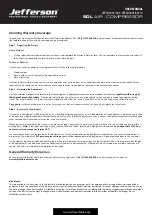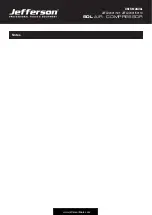
9
USER MANUAL
JEFLD2001/50
•
JEFLD2001/50110
50L
AIR COMPRESSOR
www.jeffersontools.com
8. OPERATION GUIDE
WARNING:
Take care when selecting tools for use with the compressor. Air tool manufacturers normally express the volume of air required to
operate a tool in cubic feet per minute (cfm). This refers to free air delivered by the compressor (‘air out’) which varies according to the pressure
setting. Do not confuse this with the compressor displacement which is the air taken in by the compressor (‘air in’). ‘Air out’ is always less than ‘air
in’ due to losses within the compressor.
Starting The Compressor:
Before starting the compressor check that the Pressure / ON/OFF switch is in the “OFF” position, the regulator tap is closed, the output gauge
must read Zero ‘0’ bar.
Plug mains lead into mains supply and start the compressor by moving the main switch to the ‘ON’ position.
The pressure switch automatically controls the power to the motor. It also allows for manual operation via the Push/Pull - On/Off switch on top of
the pressure switch.
Use the Pressure Switch controls (see #4 Page 4) to turn the compressor "ON/OFF". The Pressure Switch is a push/pull switch type. To turn the
compressor ‘ON’ pull the switch knob upwards. To turn the compressor 'OFF’ push the knob downwards.
The pressure switch is factory set to turn the compressor on when the tank pressure drops below 85 psi and turn itself off again when the tank is
full.
Note:
When starting the compressor for the first time, leave it running with no air tools connected to the air outlet. Make sure that pressure in
the tank rises and that the compressor stops automatically when the maximum pressure is reached - this information is indicated on the data
specification plate and shown on the pressure gauge.
The compressor will now operate automatically. The pressure switch stops the motor when the maximum tank pressure is reached and restarts it
when the pressure falls below the minimum threshold - approx. 2 bar (29psi) less than the maximum pressure.
Stopping The Compressor:
Stop the compressor by moving the main switch to the ‘OFF ‘position. The compressed air inside the compressor head will flow out, making the
restart easier and preventing the motor from being damaged. DO NOT, other than in an emergency, stop the compressor by switching off the
mains socket, or by pulling the plug out, as the pressure relief will not then operate and motor damage may result upon restart.
When the compressor runs correctly and is stopped correctly there will be:
(1)
a whistle of compressed air when the motor stops,
(2)
a protracted whistle (about 20-25 seconds) when the compressor starts with no pressure in the tank.
Regulating The Pressure:
The output pressure is regulated by the pressure regulator. Lift and turn the knob clockwise to increase pressure and anticlockwise to reduce
it - push knob down to lock in required position. To determine the correct working pressure for any piece of equipment check the corresponding
manual for your tool.
When the compressor is not being used set the regulated pressure to zero so as to avoid damaging the pressure regulator.
WARNING:
If the motor does not cut in and out, but runs continuously when using an air appliance, the capacity of the compressor may be too
small for the equipment or tool. The gauge indicates the pressure inside the main tank, NOT the pressure supplied to the air equipment. Should
the pressure in the main tank exceed the pre-set switch maximum, a safety valve will activate.
For this reason DO NOT tamper with, or adjust,
the switch or safety valve.
When the compressor is not in use, it should be switched off, disconnected from the mains supply and the air drained from the tank.






































